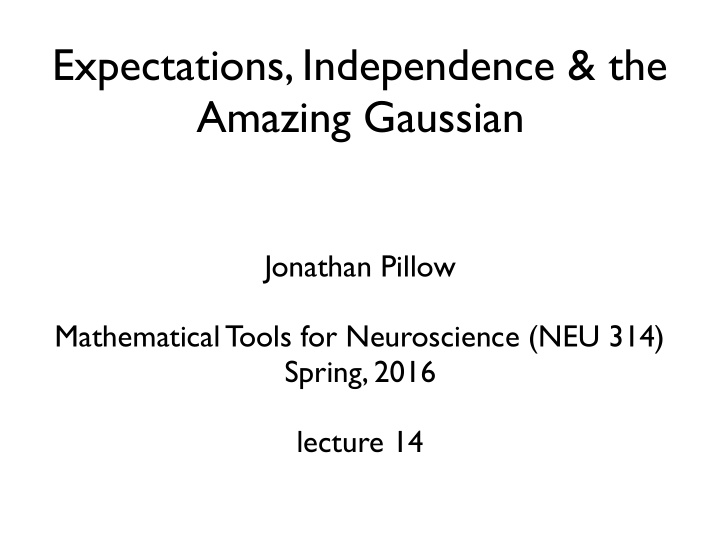



Expectations, Independence & the Amazing Gaussian Jonathan Pillow Mathematical Tools for Neuroscience (NEU 314) Spring, 2016 lecture 14
Expectations (“averages”) (on board) Expectation is the weighted average of a function (of some random variable) according to the distribution (of that random variable) pdf cdf or Corresponds to taking weighted average of f(X), weighted by how probable they are under P(x). Our two most important expectations (also known as “moments”): • Mean: E[x] (average value of RV) • Variance: E[(x - E[x]) 2 ] (average squared dist between X and its mean). Note that it’s really just a dot product! Thus a linear function: Note: expectations don’t always exist! e.g. Cauchy: has no mean!
Monte Carlo integration • We can compute expectation of a function f(x) with respect to a distribution p(x) by sampling from p, and taking the average value of f over these samples x i ∼ p ( x ) sample 1 Z X f ( x i ) − p ( x ) f ( x ) dx then average → n
Recap of last time • marginal & conditional probability • Bayes’ rule (prior, likelihood, posterior) • independence
Joint Distribution 3 2 1 0 − 1 − 2 − 3 − 3 − 2 − 1 0 1 2 3
independence Definition: x , y are independent iff (“if and only if”) 3 2 1 0 − 1 − 2 − 3 − 3 − 2 − 1 0 1 2 3
independence Definition: x , y are independent iff (“if and only if”) 3 2 In linear algebra terms: 1 0 (outer product) − 1 − 2 − 3 − 3 − 2 − 1 0 1 2 3
independence Original definition: 3 2 Equivalent definition: 1 for all x 0 − 1 All conditionals are the same! − 2 − 3 − 3 − 2 − 1 0 1 2 3 -3 -2 -1 0 1 2 3
independence Original definition: 3 2 Equivalent definition: 1 for all x 0 − 1 All conditionals are the same! − 2 − 3 − 3 − 2 − 1 0 1 2 3 -3 -2 -1 0 1 2 3
Correlation vs. Dependence positive correlation negative correlation 1. Correlation − 3 − 2 − 1 0 1 2 3 3 3 2 2 1 1 0 0 − 1 1 − 2 2 − 3 3 − 3 − 2 − 1 0 1 2 3 Linear relationship between x and y
Correlation vs. Dependence positive correlation negative correlation 1. Correlation − 3 − 2 − 1 0 1 2 3 3 3 2 2 1 1 0 0 − 1 1 − 2 2 − 3 3 − 3 − 2 − 1 0 1 2 3 Linear relationship between x and y 2. Dependence • arises whenever • quantified by mutual information: KL divergence • MI=0 ⇒ independence
Correlation vs. Dependence Q : Can you draw a distribution that is uncorrelated but dependent?
Correlation vs. Dependence Q : Can you draw a distribution that is uncorrelated but dependent? P(filter 2 output | filter 1 output) “Bowtie” dependencies filter 2 output in natural scenes: (uncorrelated but dependent) [Schwartz & Simoncelli 2001] filter 1 output
Is this distribution independent? 3 2 1 0 − 1 − 2 − 3 − 3 − 2 − 1 0 1 2 3
Is this distribution independent? 3 2 1 0 − 1 − 2 − 3 − 3 − 2 − 1 0 1 2 3
Is this distribution independent? 3 2 1 0 − 1 − 2 − 3 − 3 − 2 − 1 0 1 2 3 − 3 − 2 − 1 0 1 2 3 No! Conditionals over y are different for different x!
FUN FACT: Gaussian is the only distribution that can be both: • independent (equal to the product of its marginals) • spherically symmetric: orthogonal matrix Corollary: circular scatter / contour plot not su ffi cient to show independence!
the amazing Gaussian What else about Gaussians is awesome? Gaussian family closed under many operations: 1. scaling: is Gaussian 2. sums: is Gaussian (thus, any linear function Gaussian RVs is Gaussian) Gaussian 3. products of Gaussian distributions density
the amazing Gaussian 4. Average of many (non-Gaussian) RVs is Gaussian! Central Limit Theorem: standard Gaussian • explains why many things (approximately) Gaussian distributed coin flipping: http://statwiki.ucdavis.edu/Textbook_Maps/General_Statistics/Shafer_and_Zhang's_Introductory_Statistics/06%3A_Sampling_Distributions/6.2_The_Sampling_Distribution_of_the_Sample_Mean
the amazing Gaussian mean cov (The random variable X is Multivariate Gaussians: distributed according to a Gaussian distribution) 5. Marginals and conditionals (“slices”) are Gaussian 6. Linear projections:
multivariate Gaussian
covariance x2 x1 after mean correction:
700 samples Measurement (sampling) Inference true mean: [0 0.8] sample mean: [-0.05 0.83] true cov: [1.0 -0.25 sample cov: [0.95 -0.23 -0.25 0.3] -0.23 0.29]
Summary • Expectation • Moments (mean & variance) • Monte Carlo Integration • Independence vs. Correlation • Gaussians • Central limit theorem • Multivariate Gaussians • Covariance
Recommend
More recommend